A style that appeared in the early eighteenth-century was the 'robe volante', a flowing gown, that became popular towards the end of King Louis XIV’s reign. This gown had the features of a bodice with large pleats flowing down the back to the ground over a rounded petticoat. The colour palate was rich, dark fabrics accompanied by elaborate, heavy design features. After the death of Louis XIV the clothing styles began to change. The fashion took a turn to a lighter, more frivolous style, transitioning from the baroque period to the well-known style of Rococo. The later period was known for their pastel colours, more revealing frocks, and the plethora of frills, ruffles, bows, and lace as trims. Shortly after the typical women’s Rococo gown was introduced, robe à la Françoise, a gown with a tight bodice that had a low cut neckline, usually with a large ribbon bows down the centre front, wide panniers, and was lavishly trimmed in large amounts of lace, ribbon, and flowers.
The Watteau pleats also became more popular, named after the painter Jean-Antoine Watteau, who painted the details of the gowns down to the stiches of lace and other trimmings with immense accuracy. Later, the 'pannier' and 'mantua' became fashionable around 1718, they were wide hoops under the dress to extend the hips out sideways and they soon became a staple in formal wear. This gave the Rococo period the iconic dress of wide hips combined with the large amount of decoration on the garments. Wide panniers were worn for special occasions, and could reach up to 16 feet (4.8 metres) in diameter, and smaller hoops were worn for the everyday settings. These features originally came from seventeenth-century Spanish fashion, known as 'guardainfante', initially designed to hide the pregnant stomach, then reimagined later as the pannier. 1745 became the Golden Age of the Rococo with the introduction of a more exotic, oriental culture in France called ‘a la turque’. This was made popular by Louis XV’s mistress, Madame Pompadour, who commissioned the artist, Charles Andre Van Loo, to paint her as a Turkish sultana. In the 1760s, a style of less formal dresses immerged and one of these was the 'polonaise', with inspiration taken from Poland. It was shorter than the French dress, allowing the underskirt and ankles to be seen, which made it easier to move around in. Another dress that came into fashion was the ‘robe a l’anglais’, which included elements inspired by the males’ fashion; a short jacket, broad lapels and long sleeves. It also had a snug bodice, a full skirt without panniers but still a little long in the back to form a small train, and often some type of lace kerchief worn around the neck. Another piece was the 'redingote', halfway between the a cape and an overcoat.
Accessories were also important to all women during this time, as they added to the opulence and the decor of the body to match their gowns. At any official ceremony ladies were required to cover their hands and arms with gloves if their clothes were sleeveless.
Women's fashion
Overview
Women's clothing styles retained the emphasis on a narrow, inverted conical torso, achieved with boned stays, above full skirts. Hoop skirts continued to be worn, reaching their largest size in the 1750s, and were sometimes replaced by side-hoops, also called 'false hips', or panniers. Court dress had little or no physical comfort with restriction of movement. Full size hoops skirts prevented sitting and reminded those wearing them to stand in the presence of the King. Stays forced a proper standing posture. Garments like these could not be washed often because of the fabrics from which they were made. The Enlightenment produced a backlash against sumptuary laws which asserted a stagnant social hierarchy. During the Enlightenment, court dress stayed almost the same while outside of court dress, fashion became less extravagant and shifted more towards comfort rather than courtly display.
The late baroque or rococo, with its distinctive sweetness and elegance, arises in architecture and visual art. The clothing has light pastel shades, and ruffles and accessories come back. Louis is not interested in state affairs or the poor people. His mistress, Madame de Pompadour, influences fashion: it is feminine, playful and airy. The Age of Enlightenment began, characterized by an informal clothing style with accessories and motifs from nature. There is civilized conversations and people read a lot.
The Robe Volante came into fashion for women: a pretty shapeless dress with petticoats and a dress with a wide double (Watteau) fold on the shoulders. The décolleté is usually square. The hairs are tied back and lightly decorated. This has a tight, V-shaped body with bows and décolleté, and sleeves with cuffs. The skirt or panier is becoming wider and more pompous and around 1765 sometimes has a diameter of 5 meters, so women have to go sideways through a door. Women powder their own hair with chalk or flour. They wear it briefly, with curls around the head, or put up and covered with a flat hat with hanging ribbons or a bouquet. A lot of powder and rouge is used.
During the rococo the men's clothing will be less substantial. The tailored jacket has a flared back panel; the ruffles of the shirt come out. The stockings get a lighter color and the man wears black low shoes with a silver buckle. New is the English redingote, a buttoned long dressing gown. The wigs are less heavily powdered and white.
The industrial revolution, which had begun in the United Kingdom, completely revolutionized the means of making clothing. Until then, the fabrics and the clothes were produced manually, and by means craftsmanship. The creation of spinning jenny in 1764 by the British James Hargreaves and later spinning mule.
Fashion changed more and more frequently, but only rich people could afford the luxury of getting the latest fashion trend. However, many people still preferred to wear clothes made by a craftsman when they could pay for it. Other people, especially those in isolated places, continued to make fabrics and clothing at home.
1750s
Women: Court dress included elaborate and intricate styles influenced by Rococo; hoop skirts; panniers; corsets; petticoats; stays; conical torso shape with large hips; "standardized courtly bodies and faces" with little individuality
French: Elaborate court dress, colorful,decorative, portraiture inside
English: Simple and practical, inexpensive durable fabrics, outdoor lifestyle, portraiture outside
1760s
Women: New strapless stays cut high at the armpit; grand habit de cour or "stiff-bodied" gown; riding habit
1770s
Women: robe à la française or sack-back gown; robe à l'anglaise or close-bodied gown; the Brunswick; tall hair and headdresses
Gowns
The usual fashion of the years 1750–1775 was a low-necked gown (usually called in French a robe), worn over a petticoat. Most gowns had skirts that opened in front to show the petticoat worn beneath. If the bodice of the gown was open in front, the opening was filled in with a decorative stomacher, pinned to the gown over the laces or to the stays beneath.
Close-fitting sleeves just past the elbow were trimmed with frills or ruffles, and separate under-ruffles referred to as engageantes in modern terms, of lace or fine linen were tacked, to the inside of the gown’s sleeves, or perhaps to the shift or chemise sleeves. The neckline was trimmed with a fabric or lace ruffle, or a neckerchief called a fichu could be tucked into the low neckline. Women would also sometimes wear a neckerchief or a more formal lace modesty piece, particularly on low-cut dresses.
The robe à la française or sack-back gown featured back pleats hanging loosely from the neckline. A fitted bodice held the front of the gown closely to the figure.
The robe à l'anglaise or close-bodied gown featured back pleats sewn in place to fit closely to the body, and then released into the skirt which would be draped in various ways.
The Brunswick dress was a two-piece costume of German origin consisting of a hip-length jacket with "split sleeves" (flounced elbow-length sleeves and long, tight lower sleeves) and a hood, worn with a matching petticoat. It was popular for traveling.
Court dress, the grand habit de cour or "stiff-bodied" gown, retained the styles of the 1670s. It featured a low, oval neckline that bared the shoulders, and the heavily boned bodice laced closed in back, unlike the front-opening robe. The elbow-length sleeves were covered with tiers of lace flounces, echoing the full-sleeved chemise worn with the original style.
Front-wrapping thigh-length shortgowns or bedgowns of lightweight printed cotton fabric were fashionable at-home morning wear, worn with petticoats. Over time, bedgowns became the staple upper garment of British and American female working-class street wear.
As in previous periods, the traditional riding habit consisted of a tailored jacket like a man's coat, worn with a high-necked shirt, a waistcoat, a petticoat, and a hat. Alternatively, the jacket and a false waistcoat-front might be a made as a single garment, and later in the period a simpler riding jacket and petticoat (without waistcoat) could be worn.
The swinging dress ;
The "Polish dress" whose skirt has three ruffles on circular baskets ;
The French dress (universal term, but which also has equivalents: "contouche" in German, "Andrienne" in Italian, "sack-dress" in English It was said once sack in France, but the term was lost) with or without folds Watteau (or Watteau) and with a piece of stomach or accomplices according to the time;
The English dress, a dress with fitted bodice, puffed sleeves, collar and 'vertugadin' wider than the shoulders.
The skirts of the dresses can be worn with a fart-in-the-air or baskets (there are a large number of baskets during the xviii th century, including the court baskets, considerations or baskets to jansenist). According to Honore de Balzac, the baskets would have their origin in England. "
Underwear
The shift, chemise (in France), or smock, had a low neckline and elbow-length sleeves which were full early in the period and became increasingly narrow as the century progressed. Drawers were not worn in this period.
The long-waisted, heavily boned stays of the early 1740s with their narrow back, wide front, and shoulder straps gave way by the 1760s to strapless stays which still were cut high at the armpit, to encourage a woman to stand with her shoulders slightly back, a fashionable posture. The fashionable shape was a rather conical torso, with large hips. The waist was not particularly small. Stays were laced snugly, but comfortably. They offered back support for heavy lifting, and poor and middle class women were able to work comfortably in them.
Free-hanging pockets were tied around the waist and were accessed through pocket slits in the side-seams of the gown or petticoat.
Woollen or quilted waistcoats were worn over the stays and under the gown for warmth, as were petticoats quilted with wool batting, especially in the cold climates of Northern Europe and America. In the 1770s stays began to be produced so they would end higher on a woman's body. Phillip Vicker complained: ''For the late importation of Stays which are said to be now most fashionable in London, are produced upwards so high that we can have scarce any view at all of the Ladies Snowy Bosoms...''
The bodice is adjusted with a " whale body " or boned (ancestor of the corset), also simply says "the body" or a white corset.
The top of women's clothing includes the camisole, the casaquin, the pierrot, the fair, called mantelet in Quebec.
Shoes
Shoes had high, curved heels (the origin of modern "louis heels") and were made of fabric or leather, with separate shoe buckles. These were either shiny metal, usually in silver (sometimes with the metal cut into false stones in the Paris style), or with paste stones, although there were other types.
Hairstyles and headgear
By the 1770s extreme hairstyles and wigs had come into fashion. Women wore their hair high upon their heads, in large plumes. To create tall extreme hair, rolls of horse hair, tow, or wool was used to raise up the front of the hair. The front of the hair was then frizzed out, or arranged in roll curls and set horizontally on the head. Women turned their hair up in the back often in a knot. In addition, pomatum and false hair was used to give more height to the hair. Pomatum was paste that women used to stiffen their hair. Pomatum was also used to hold powder, which women put in their hair. The Pomatum was made of many ingredients including hog's grease, tallow, or a mix of beef marrow and oil.
Style gallery 1750–1775
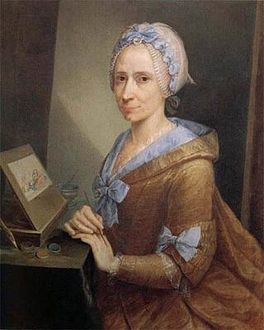
1 - c. 1750
| 
2 – 1755
| 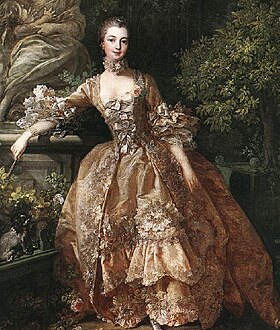
3 – 1759
| 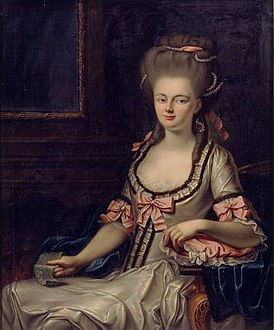
4 - 1760
| 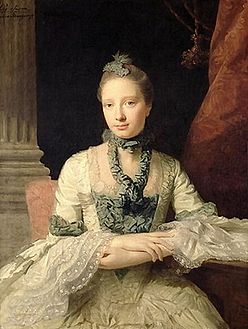
5 - 1761
|
|---|---|---|---|---|
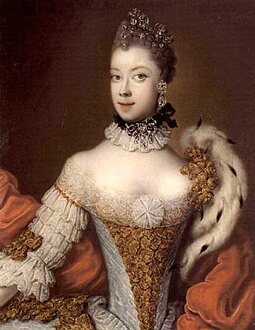
6 - 1761
| 
7 - 1763
| 
8 - 1763
| 
9 - 1764
| 
10 - 1771
|
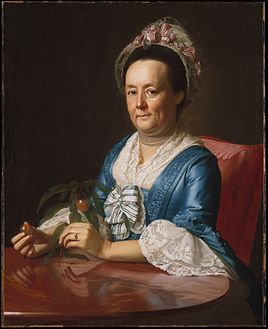
11 – 1773
| 
12 – 1774
|
1.Self-portrait of Anna Bacherini Piattoli wearing a Brunswick.
2.1755 portrait of Madame de Pompadour wearing a floral gown with matching petticoat. Her sleeves end in flounces worn over lace engageantes. Her stomacher is decorated with a vertical row of ribbon bows.
3.1759 portrait of Madame de Pompadour shows her petticoat trimmed with flounces to match her gown. She wears a small lace ruff around her neck.
4.Elisabeth Freudenrich wears a gown trimmed with silk ribbons. Her hair is dressed high and two curls frame her neck, 1760.
5.Lady Susan Fox-Strangways's gown is worn with wide, tiered engageantes, 1761.
6.Queen Charlotte wears an elaborate neck ruffle with a large diamond brooch with her court gown. Her figure shows the full, rounded bust and small waist created by narrow-backed stays, 1761.
7.In the American colonies Mrs. John Murray wears a simple gown with cuffed sleeves, 1763.
8.Mrs. Benjamin Pickman, the wife of a wealthy merchant of Salem, Massachusetts, wears a blue silk gown with robings. She carries a parasol, 1763.
9.Mrs. Epes Sargent II wears a dark blue riding habit and carries a plumed hat, Massachusetts, 1764.
10.Marie Antoinette at age 15 wears a riding habit with a striped waistcoat. Her hair is tied back and she wears a tricorn hat, France, 1771.
11.Mrs John Winthrop of Boston, Massachusetts, in the fashionable dress of 1773. Her indoor cap is trimmed with striped and dotted ribbons, and her gown is trimmed with robings of ruched fabric (strips of fabric gathered on two sides). A lace fichu fills in her neckline.
12.Side view of a frock of 1774 shows pleated robings and striped ribbon rosettes.
French fashion

France, 1751
| 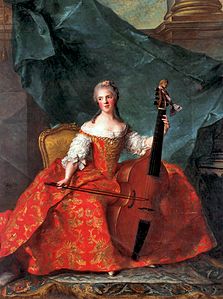
France, 1754
| 
France, 1754
| 
France, 1756
| 
France, 1757
|
|---|---|---|---|---|

France, 1758
| 
France, 1759
| 
France, 1762
| 
France, 1764
| 
France, 1766
|

France, 1769
| 
France, 1770
| 
France, 1770
| 
France, 1775
|
Source from Wikipedia
没有评论:
发表评论